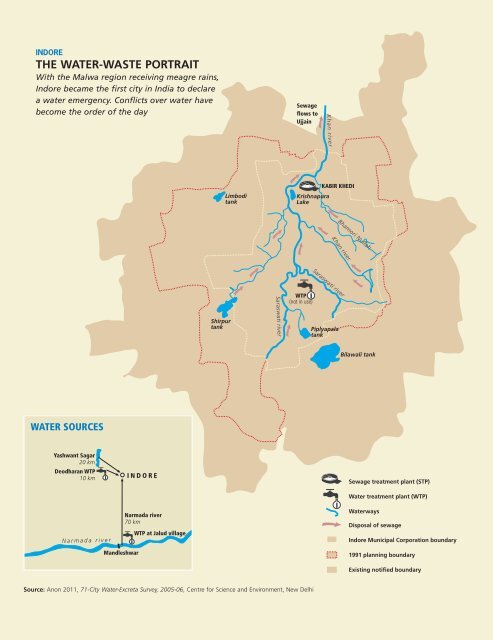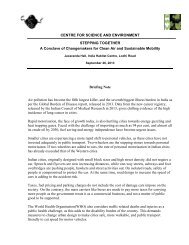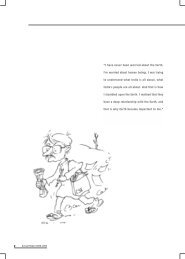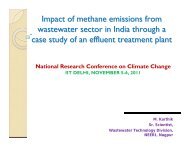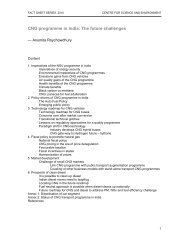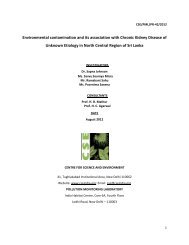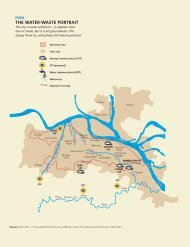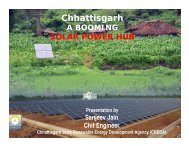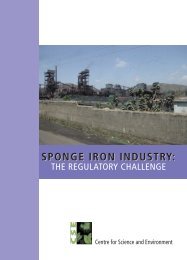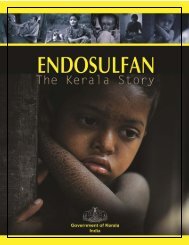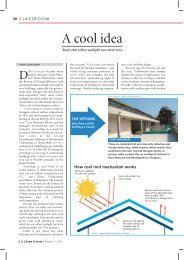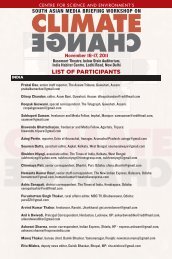Indore The Water-Waste Portrait - Centre for Science and Environment
Indore The Water-Waste Portrait - Centre for Science and Environment
Indore The Water-Waste Portrait - Centre for Science and Environment
Create successful ePaper yourself
Turn your PDF publications into a flip-book with our unique Google optimized e-Paper software.
INDORE<br />
THE WATER-WASTE PORTRAIT<br />
With the Malwa region receiving meagre rains,<br />
<strong>Indore</strong> became the first city in India to declare<br />
a water emergency. Conflicts over water have<br />
become the order of the day<br />
WATER SOURCES<br />
Yashwant Sagar<br />
20 km<br />
Deodharan WTP<br />
10 km<br />
Narmada river<br />
M<strong>and</strong>leshwar<br />
INDORE<br />
Narmada river<br />
70 km<br />
WTP at Jalud village<br />
Shirpur<br />
tank<br />
Limbodi<br />
tank<br />
Saraswati river<br />
Sewage<br />
flows to<br />
Ujjain<br />
KABIR KHEDI<br />
Krishnapura<br />
Lake<br />
WTP<br />
(not in use)<br />
Source: Anon 2011, 71-City <strong>Water</strong>-Excreta Survey, 2005-06, <strong>Centre</strong> <strong>for</strong> <strong>Science</strong> <strong>and</strong> <strong>Environment</strong>, New Delhi<br />
Khan river<br />
Bhamori Nullah<br />
Khan river<br />
Saraswati river<br />
Piplyapala<br />
tank<br />
Bilawali tank<br />
Sewage treatment plant (STP)<br />
<strong>Water</strong> treatment plant (WTP)<br />
<strong>Water</strong>ways<br />
Disposal of sewage<br />
<strong>Indore</strong> Municipal Corporation boundary<br />
1991 planning boundary<br />
Existing notified boundary
MADHYA PRADESH<br />
<strong>Indore</strong><br />
<strong>Indore</strong> is the commercial capital of Madhya Pradesh. <strong>The</strong> city<br />
can no longer meet its water requirement through its<br />
traditional lakes <strong>and</strong> borewells, <strong>and</strong> has now turned to the<br />
Narmada. Pipelines draw water from the river <strong>for</strong> the city at<br />
exorbitant costs. In spite of this, <strong>Indore</strong>, like most cities of India,<br />
has not learnt its lesson. It continues to discharge its wastes into<br />
the Khan river, which has been converted into an open sewer. In<br />
its turn, the Khan pollutes the water source of another city: Ujjain,<br />
located in its downstream.<br />
WATER<br />
DEMAND AND SUPPLY<br />
Currently, <strong>Indore</strong> has to bear with a 16 per cent gap between its<br />
dem<strong>and</strong> <strong>and</strong> supply of water. Official dem<strong>and</strong> estimations do not<br />
match the figures put <strong>for</strong>ward by the CPHEEO: they are almost<br />
23 per cent lower. With the city’s high leakage losses, the supply<br />
reduces further (see Table: <strong>The</strong> water).<br />
<strong>The</strong> governing agency, <strong>Indore</strong> Municipal Corporation (IMC),<br />
draws water from the Narmada river, the Yashwant Sagar Lake,<br />
Bilawali tank <strong>and</strong> a few local borewells. Besides the Bilawali, the<br />
city has two other large tanks – the Piplyapala <strong>and</strong> the Shirpur.<br />
But constructions in their catchments have drastically reduced<br />
their water inflow. <strong>The</strong> contribution from groundwater is minimal<br />
– in 2005-06, there were some 1,500 public tubewells fitted with<br />
power pumps, 446 h<strong>and</strong>pumps <strong>and</strong> 125 open wells supplying<br />
about 17.5 million litre a day (MLD). 1<br />
Though the city gets 210 MLD of water from the Narmada,<br />
11 MLD is provided to the military headquarters at Mhow town,<br />
while about 2 MLD goes to villages near the city. Another 9 MLD is<br />
sent directly to Dewas town through a separate transmission<br />
pipeline. Thus, only about 160 MLD of treated water is available<br />
from the Narmada to the IMC. 2<br />
Given the poor state of supply, a virtual scarcity is not hard to<br />
imagine. <strong>The</strong> crisis appears deeper by the fact that about 46 per<br />
cent of the city residents do not have access to piped water. 3 In<br />
fact, with the entire Malwa region receiving less than half the<br />
average rainfall in 2008, <strong>Indore</strong> became the first city in India to<br />
declare a water emergency in the following year (see Box at the<br />
end of this chapter: A state of emergency).<br />
THE SOURCES<br />
In the 1930s, <strong>Indore</strong> had got its water from the Bilawali <strong>and</strong><br />
Limbodi water tanks, as well as from the Yashwant Sagar Dam.<br />
<strong>The</strong> dam was built on the Gambhir river 20 km from the city in<br />
1938, by the then ruler of <strong>Indore</strong>, Yashwant Rao Holkar. 4<br />
THE CITY<br />
Municipal area (<strong>Indore</strong> Municipal Corporation) 134 sq km<br />
Total area (total planning area) 504.87 sq km<br />
Population (2005) 1.8 million<br />
Population (2011), as projected in 2005-06 2.4 million<br />
THE WATER<br />
Dem<strong>and</strong><br />
Total water dem<strong>and</strong> as per city agency (IMC) 243 MLD<br />
Per capita water dem<strong>and</strong> as per IMC 135 LPCD<br />
Total water dem<strong>and</strong> as per CPHEEO @ 175 LPCD<br />
Sources <strong>and</strong> supply<br />
315 MLD<br />
<strong>Water</strong> source Surface* <strong>and</strong><br />
groundwater<br />
Percentage of water sourced from surface sources 94%<br />
Percentage of water sourced from groundwater 6%<br />
Total water supplied 204 MLD<br />
Per capita supply 113 LPCD<br />
Leakage loss 35%<br />
Actual supply (after deducting leakage losses) 133 MLD<br />
Per capita supply (after deducting leakage losses) 74 LPCD<br />
Population served by water supply system 54%<br />
Per capita supply to the served area NA<br />
Dem<strong>and</strong>-supply gap (after leakage loss)<br />
Treatment<br />
110 MLD<br />
Number of WTPs 3<br />
Total treatment capacity 185 MLD<br />
Actual treatment<br />
Future dem<strong>and</strong> <strong>and</strong> supply<br />
182 MLD<br />
Dem<strong>and</strong> (2011), as projected in 2005-06 329 MLD<br />
Augmentation needed to meet 2011 water dem<strong>and</strong> 125 MLD<br />
Required increase in supply 61%<br />
THE SEWAGE<br />
Generation<br />
Sewage generated as per CPCB 239 MLD<br />
Sewage generated as per city agency<br />
Collection<br />
80 MLD<br />
Length of sewerage network 600 km**<br />
Population covered by sewerage network 55%<br />
Area covered by sewerage network<br />
Treatment<br />
10%<br />
Number of STPs 2<br />
Total treatment capacity 90 MLD<br />
Actual sewage treated 78 MLD<br />
Disposal Khan<br />
river***<br />
Source: Anon 2011, 71-City <strong>Water</strong>-Excreta Survey, 2005-06, <strong>Centre</strong> <strong>for</strong> <strong>Science</strong><br />
<strong>and</strong> <strong>Environment</strong>, New Delhi<br />
Notes: *<strong>The</strong> Narmada river, Yashwant Sagar Lake <strong>and</strong> Bilawali tank; **80 per<br />
cent of the sewers are under-utilised due to lack of maintenance ; ***<strong>The</strong> Khan<br />
joins the Kshipra river, Ujjain’s water source; IMC: <strong>Indore</strong> Municipal Corporation<br />
CENTRAL HIGHLANDS INDORE | 255
TABLE: INDORE’S WATER SOURCES<br />
<strong>The</strong> city’s dependence on the Narmada is now<br />
overwhelming<br />
Source Distance Capacity Supply<br />
(in km) (in MLD) (in MLD)<br />
Bilawali 5 9 4<br />
Yashwant Sagar 21 38 27<br />
Tubewells etc – 27 13<br />
Narmada river 70 210 160<br />
Source: Based on data received from <strong>Indore</strong> Municipal Corporation, 2005-06<br />
In the 1970s, with these water bodies unable to meet <strong>Indore</strong>’s<br />
growing dem<strong>and</strong>s, a master plan <strong>for</strong> water based on projected<br />
population growth was developed <strong>for</strong> the region. Under this<br />
plan, the Narmada water supply scheme was installed in 1977; it<br />
started providing 86 MLD, which was augmented to 172 MLD in<br />
1990 (the CSE survey, however, had put supply from the scheme<br />
at 160 MLD. 5<br />
GROUNDWATER IN INDORE<br />
Studies find worrying trends<br />
Low per capita supply <strong>and</strong> lack of water connections to most parts of<br />
the city puts immense stress on groundwater. In 1998, a study of 200<br />
borewells in the city by Deepak Khare, senior lecturer, Shri GS Institute<br />
of Technology <strong>and</strong> <strong>Science</strong>, <strong>Indore</strong>, found that wells were drying up at<br />
an alarming rate. In 1988, 0.5 per cent of the population had faced a<br />
19.9<br />
256 | EXCRETA MATTERS 71 CITIES<br />
18.94<br />
33.29<br />
33.09<br />
As said be<strong>for</strong>e, the city depends heavily on the Narmada<br />
today (see Table: <strong>Indore</strong>’s water sources). A 1,200 mm-diameter<br />
pipeline brings the river’s water over a 110 km distance. Because<br />
of the single pipeline, any break in supply – due to power failure<br />
or maintenance work – wreaks havoc in the city. Moreover, it has<br />
to be remembered that Narmada water is supplied to only 80 per<br />
cent of the city; <strong>Indore</strong>’s fringes, where the poor live, do not get<br />
this water. 6<br />
During days of crisis, especially in summer, the IMC supplies<br />
water through its 30 tankers. Another 250 tankers are hired to<br />
carry water from the Yashwant Sagar Dam. <strong>The</strong>re are also private<br />
tankers which charge at least twice the amount asked <strong>for</strong> by the<br />
IMC’s tankers. In slums <strong>and</strong> other poorer areas, plastic water tanks<br />
have been made which the IMC fills up free of cost. 7<br />
TREATMENT AND DISTRIBUTION<br />
<strong>The</strong> raw water from Yashwant Sagar is conveyed through a 13-km<br />
pipeline to a water treatment plant (WTP) at Deodharan; there, it is<br />
treated in a conventional rapid s<strong>and</strong> gravity system. <strong>The</strong> installed<br />
capacity of the plant is 40 MLD, but because of the limited yield<br />
from Yashwant Sagar, a mere 27 MLD is produced. <strong>The</strong> scheme was<br />
reduced yield of groundwater due to the depleting aquifer – by 1998,<br />
about 40 per cent of the population was facing reduction in yield. 1<br />
<strong>The</strong> Central Pollution Control Board’s 2004 study of groundwater<br />
quality in the city (25 samples) had found more than 80 per cent of<br />
the samples to be above the desirable limit <strong>for</strong> total dissolved solids,<br />
or TDS (but within the maximum permissible limit of 2,000 mg/l).<br />
Almost all the samples exceeded the alkalinity level, while 40 per cent<br />
had high nitrate content. 2<br />
GRAPH: DIPPING LEVEL<br />
According to CGWB, the water level in the city has depleted by 14 m between 2000 <strong>and</strong> 2006 at the rate of 2.5 m per year<br />
Metre below ground level (m bgl)<br />
0<br />
5<br />
10<br />
15<br />
20<br />
25<br />
30<br />
35<br />
40<br />
45<br />
1999 2000 2001 2002 2003 2004 2005 2006<br />
Source: National Data <strong>Centre</strong>, Central Ground <strong>Water</strong> Board (CGWB), Faridabad<br />
Years<br />
33.94<br />
29.09<br />
32.79<br />
33.49
installed in 1936. Although repair works have been undertaken,<br />
what the plant needs is a complete overhaul. 8<br />
<strong>The</strong> water from Bilawali tank goes to a filter plant near<br />
Indrapuri by gravity. Earlier, this water used to be treated in five<br />
pressure filter units, which have since become defunct. <strong>The</strong> water<br />
undergoes a three-fold test every day: a physical test of around<br />
30 samples a day, a chemical test on around 17 samples <strong>and</strong> a<br />
biological test on 32 samples a day. 9<br />
<strong>The</strong> WTP <strong>for</strong> the Narmada project is 3 km away near Jalud; it<br />
has a total capacity to filter 182 MLD. Because of the high s<strong>and</strong><br />
content of Narmada waters around the project’s intake wells, the<br />
problem of desilting <strong>and</strong> severe wear <strong>and</strong> tear of pumps is<br />
persistent. 10<br />
<strong>The</strong> treated water is distributed through a 1,500-km pipeline<br />
network, covering 54 per cent of the total population. <strong>The</strong> IMC<br />
has about 1,47,000 residential, 750 commercial <strong>and</strong> 1,320<br />
industrial connections. Apart from these, water is also distributed<br />
through 7,263 public st<strong>and</strong>posts. <strong>The</strong> number of beneficiaries per<br />
st<strong>and</strong>post is about 25, which is too low <strong>for</strong> supply management –<br />
each st<strong>and</strong>post should cover at least 10 houses or about<br />
50-70 beneficiaries. 11<br />
<strong>The</strong> pressure of water in the pipelines is increased by five<br />
pumping stations. <strong>The</strong> water is carried over a hill, across<br />
20-25 km. <strong>The</strong>se pumping stations, <strong>for</strong>tified with horizontal <strong>and</strong><br />
centrifugal pumps that work <strong>for</strong> 24 hours, lift water from one<br />
point to another, where the second point is higher than the ground<br />
level of <strong>Indore</strong> city. 12<br />
From the second point, the water mainly flows by gravity to<br />
<strong>Indore</strong> <strong>and</strong> fills up 33 overhead tanks. <strong>The</strong> capacities of these<br />
tanks range between 2,250 <strong>and</strong> 3,400 kilolitre (kl), which is not<br />
enough <strong>for</strong> the whole of <strong>Indore</strong> city. About two-thirds of the<br />
city receives water through gravity, <strong>and</strong> some areas complain of<br />
low pressure. 13<br />
<strong>The</strong>re are an estimated 20,000 illegal connections. <strong>The</strong> total<br />
estimated loss of water due to these unauthorised connections<br />
as well as leakage <strong>and</strong> wastage is to the tune of 50 per cent,<br />
says the IMC. 14<br />
THE ECONOMICS<br />
In 2004-05, the IMC spent Rs 82 crore <strong>for</strong> supplying water to the<br />
city. Of this, energy took up 60 per cent – or about Rs 49 crore<br />
(see Graph: Expense heads). It collected only Rs 12 crore. Thus,<br />
while the per kl production cost <strong>for</strong> supply of 204 MLD of water<br />
stood at Rs 10.96, the revenue per kl was only Rs 2. 15<br />
<strong>The</strong> water agency was over-staffed. As of 2005-06, there were<br />
1,700 employees, including 38 engineers, which works out to over<br />
50 employees per 1,000 connections. 16<br />
<strong>The</strong> municipality earns its revenues through water tax <strong>and</strong><br />
water charges. Households in <strong>Indore</strong> are charged much higher<br />
compared to other Indian cities (see Table: Tariff structure).<br />
Domestic connections are not metered <strong>and</strong> are charged a flat<br />
amount; the tariff was raised from Rs 60 per month in 2005.<br />
Under the conditions of the ADB loan granted <strong>for</strong> the Narmada<br />
Phase-III project, the tariff will rise every year once the metering<br />
system is in place. 17<br />
GRAPH: EXPENSE HEADS<br />
With pumping being a key activity, energy costs are high<br />
17%<br />
60%<br />
Repair <strong>and</strong> maintenance Chemical<br />
22%<br />
<strong>The</strong> commercial connections which are metered are charged<br />
Rs 14 per kl, while industrial connections pay Rs 24 per kl. 18<br />
Considering low per capita supply, an average household<br />
consumes 11.09 kl per month <strong>and</strong> ends up paying Rs 5.41 per kl.<br />
Despite this, while expenses have increased over a period of time,<br />
the revenue income has remained largely stagnant (see Graph:<br />
Revenue from water). 19<br />
According to the ADB’s 2007 survey, the average monthly<br />
consumption in the city is about 28.4 cubic metre (cu m) per<br />
connection, with per capita supply at 87 LPCD. <strong>The</strong> household<br />
water bill averages Rs 60.36 per connection. Of the bulk<br />
connections, only a few are metered – <strong>and</strong> not all are working. To<br />
most users, water is available on an average of 45 minutes<br />
a day. 20<br />
1%<br />
Energy Staff salary <strong>and</strong> administration<br />
Source: Based on data received from <strong>Indore</strong> Municipal Corporation, 2005-06<br />
TABLE: TARIFF STRUCTURE<br />
<strong>Indore</strong> charges heavily <strong>for</strong> the water it supplies<br />
Flat rate (Rs/month)<br />
Size of pipe Domestic Commercial Industrial<br />
½ inch 150 300 600<br />
¾ inch 250 600 1,200<br />
1 inch 500 1,400 2,400<br />
1½ inch 1,000 2,400 5,000<br />
2 inch 2,000 5,000 10,000<br />
3 inch 4,000 10,000 20,000<br />
4 inch 8,000 20,000 35,000<br />
6 inch 14,000 38,000 76,000<br />
Metered connections <strong>for</strong> bulk connection – Rs / kl<br />
Bulk rates Rs 11 Rs 14 Rs 24<br />
Source: Anon 2008, 2007 Benchmarking <strong>and</strong> Data Book of <strong>Water</strong> Utilities in<br />
India, Union ministry of urban development <strong>and</strong> the Asian Development Bank<br />
CENTRAL HIGHLANDS INDORE | 257
GRAPH: REVENUE FROM WATER<br />
While expenses have increased over a period of time, the income has remained largely stagnant<br />
Rs in crore<br />
16<br />
14<br />
12<br />
10<br />
8<br />
6<br />
4<br />
2<br />
0<br />
SEWAGE<br />
7.41<br />
3.86<br />
<strong>Indore</strong> does not know how much sewage it generates – wide<br />
disparity, there<strong>for</strong>e, rules its estimations (see Table: <strong>The</strong> sewage). As<br />
a result, its capacity <strong>for</strong> treating sewage is also off the mark: its<br />
two sewage treatment plants (STPs) at Kabir Khedi can only treat<br />
the amount (80 MLD) that the city claims to officially generate. 21<br />
<strong>The</strong> city does not have a proper sewage collection <strong>and</strong><br />
disposal system. In 1936, its Holkar kings constructed a 30-km<br />
covered sewerage line over 10 per cent of the city’s area; the<br />
system served a population of about 150,000. In 1990, the PHED<br />
prepared a sewerage master plan <strong>for</strong> <strong>Indore</strong> till the year 2028,<br />
which included the laying of 300 km of sewer lines in phases. <strong>The</strong><br />
plan was technically approved by the CPHEEO, but could not be<br />
implemented due to lack of funds. 22<br />
Subsequently, the <strong>Indore</strong> Development Authority (IDA) – with<br />
financial assistance from the British government’s Department<br />
<strong>for</strong> International Development – built a sewerage system in<br />
183 slums: 47 km of sewer lines were installed. <strong>The</strong> IDA also<br />
constructed a 17-km sewage line on the banks of the Khan river<br />
<strong>and</strong> connected it to the city’s STP. 23<br />
Of the city’s road network of 1,710 km, only 600 km has<br />
drains; 90 per cent of the drains are open. This network collects<br />
55 per cent of the sewage that is generated in the city; another<br />
43 per cent is disposed off in septic tanks <strong>and</strong> ultimately<br />
discharged into nullahs. Of the city’s 1.8 million-strong population<br />
in 2005-06, about 0.7 million used septic tanks. Besides, about<br />
1,000 pit latrines were still in use, <strong>and</strong> about 5 per cent of the<br />
population resorted to open defecation. <strong>The</strong>re were about 1,464<br />
seats of public toilets in the city attached to septic tanks, all of<br />
which were poorly maintained. 24<br />
Most of the wastewater is drained into <strong>Indore</strong>’s three major<br />
258 | EXCRETA MATTERS 71 CITIES<br />
11.27<br />
8.71<br />
12.97<br />
R K SRINIVASAN / CSE<br />
9.55<br />
14.03<br />
7.59<br />
4.26 4.48 4.78<br />
2001-02 2002-03 2003-04 2004-05<br />
<strong>Water</strong> tax <strong>Water</strong> meter charges Total<br />
Source: Anon 2006, <strong>Indore</strong> City Development Plan, <strong>Indore</strong> Municipal Corporation, with technical support of Mehta & Associates, <strong>Indore</strong><br />
12.37<br />
<strong>The</strong> ‘sewer’ of <strong>Indore</strong>: passing right through the city, the Khan is<br />
anything but a river<br />
streams, which flow towards the north <strong>and</strong> meet at the city’s<br />
municipal borders. <strong>The</strong>se three are the Khan <strong>and</strong> Saraswati<br />
rivers, <strong>and</strong> the Piliyakhal Nullah. <strong>The</strong> IDA has laid interceptor<br />
sewers along these streams <strong>and</strong> the Plasiya Nullah to collect<br />
wastewater from the slums situated on their banks. <strong>The</strong>
TABLE: DOWNHILL<br />
<strong>The</strong> quality of the Khan river after it leaves <strong>Indore</strong><br />
Location pH DO BOD Total coli<strong>for</strong>m Faecal coli<strong>for</strong>m<br />
(mg/l) (mg/l) (MPN/100 ml) (MPN/100 ml)<br />
Khan river at Kabir Khedi 8.1 3.8 71.5 1600 120<br />
CPCB st<strong>and</strong>ard Outdoor bathing<br />
(organised)-Class B 6.5-8.5 5 or more 3 or less 500 or less –<br />
Source: Anon 2006, Status of water quality in India-2004, Central Pollution Control Board, New Delhi<br />
interceptor sewers along the other nullahs discharge into the<br />
sewers along the Khan, which conveys the sewage to the STPs at<br />
Kabir Khedi. 25<br />
<strong>The</strong> eastern parts of the city are partially sewered. <strong>Waste</strong>water<br />
from these parts flows through a brick arch sewer that finally<br />
discharges into the river Khan near Kabir Khedi. This brick arch<br />
sewer is now broken at various places – as a result, sewage<br />
bypasses it <strong>and</strong> flows into the Bhamori Nullah. 26<br />
Sewers laid under a British Overseas Development<br />
Administration-assisted project have collapsed as well; most are<br />
reported to be broken or choked at various locations. As a result,<br />
the sewage had been flowing directly into the Khan. As a<br />
temporary arrangement, a weir has now been built across the<br />
river to divert the sewage into the STPs. Since the STPs cannot<br />
h<strong>and</strong>le all the sewage generated by <strong>Indore</strong>, about 73 MLD of<br />
untreated sewage goes directly into the Khan river. However,<br />
considering the poor condition of sewage drains, the actual<br />
amount of sewage reaching the STPs could be much less. 27<br />
<strong>The</strong> Khan river, naturally, is in a sorry state. It has also<br />
A CLOSE LOOK AT THE INDORE SLUM MODEL<br />
Project receives awards <strong>and</strong> accolades, while people die due<br />
to its drawbacks<br />
October 1987: Department <strong>for</strong> International Development, earlier<br />
known as the British Overseas Development Administration (ODA),<br />
proposes a slum project <strong>for</strong> <strong>Indore</strong><br />
March 1988: Assistance worth Rs 39 crore <strong>for</strong> the <strong>Indore</strong> Habitat<br />
Improvement Project <strong>for</strong> upgrading 183 slums (80,000 families) over<br />
five years<br />
1990: Project gets underway<br />
January 1993: <strong>The</strong> then prime minister of UK, John Major, visits the<br />
site <strong>and</strong> is “very pleased”. <strong>The</strong> project’s duration is extended to 1995<br />
<strong>and</strong> the aid to Rs 42.4 crore.<br />
Mid-1993: Complaints of water-borne diseases surface. Crosscontamination<br />
of drinking water <strong>and</strong> sewage lines <strong>and</strong> the first death<br />
due to jaundice reported.<br />
polluted the Kshipra river, which is the main water source <strong>for</strong><br />
Ujjain, <strong>and</strong> is located downstream of <strong>Indore</strong> (see Table: Downhill).<br />
LOOKING AHEAD<br />
By the year 2011, as per calculations done in 2005-06, <strong>Indore</strong><br />
would have needed an estimated 394 MLD at the rate of 135 LPCD. 28<br />
In 2005-06, the city got 45 minutes of water supply on alternate<br />
days, covering 54 per cent of the population, with average supply<br />
at 80 LPCD. According to its City Development Plan (CDP), it aims <strong>for</strong><br />
a 24-hour supply, with 100 per cent coverage by 2010. Amar Ujala,<br />
a local newspaper, reported in February 2011 that the French<br />
Veolia <strong>and</strong> the Delhi-based SPMCL had come up through a sevencompany<br />
pre-bid process as possible contenders <strong>for</strong> executing a<br />
24x7 water supply project. 29<br />
As far as sewerage is concerned, about 55 per cent of the<br />
population has access to a sewerage network – but 80 per cent of<br />
these sewers are choked. By 2020, <strong>Indore</strong> wants 100 per cent of its<br />
July 1994: In UK, the Building <strong>and</strong> Social Housing Foundation presents<br />
the World Habitat Award to the project. Project duration is further<br />
extended to 1997 <strong>and</strong> funding to Rs 60.5 crore. Rains, meanwhile,<br />
compound the residents’ misery.<br />
June 1996: <strong>Indore</strong>’s slum networking included in the national best<br />
practices <strong>and</strong> selected as a global best practice.<br />
1997: ODA detects major sanitation problems in an assessment. <strong>The</strong><br />
<strong>Indore</strong> Development Authority denies the scale of the problem <strong>and</strong><br />
attributes it to a poor sample.<br />
June 1998: Deaths due to malaria <strong>and</strong> water-borne diseases<br />
reported. Over half of the drinking water samples collected are found<br />
unsafe.<br />
October 1998: Project bags the Aga Khan Award <strong>for</strong> Architecture <strong>for</strong><br />
“trans<strong>for</strong>ming the environment <strong>and</strong> improving the quality of life by<br />
providing a clean <strong>and</strong> liveable habitat <strong>for</strong> its citizens”! 1<br />
CENTRAL HIGHLANDS INDORE | 259
ARVIND YADAV / CSE<br />
<strong>The</strong> Yashwant Sagar: <strong>Indore</strong>’s planners are thinking of building a barrage here to meet the city’s future needs<br />
population covered under its sewerage system. About 35 per cent<br />
of the city’s population lives in slums today; the CDP aims <strong>for</strong> a<br />
“slum-less <strong>Indore</strong> by 2015”. 30<br />
What is the city doing to meet these targets it has set itself? <strong>The</strong><br />
IMC has begun execution of Phase-III of the Narmada project with<br />
ADB assistance; the project, which was expected to be completed<br />
A STATE OF EMERGENCY<br />
In 2009, this is how <strong>Indore</strong> prepared <strong>for</strong> parched times<br />
For the first time in India, a city was <strong>for</strong>ced to declare a water<br />
emergency – thanks to the complete mismanagement of its water<br />
resources, said activists in <strong>Indore</strong>. Though there is no legal provision <strong>for</strong><br />
declaring such an emergency, the move was validated by the fact that<br />
the city’s mayor-in-council had passed the decision.<br />
<strong>The</strong> emergency involved measures <strong>for</strong> preventing water loss,<br />
freeing public tubewells from encroachments, acquiring private<br />
borewells, tackling corruption in water distribution <strong>and</strong> preventing<br />
water misuse.<br />
<strong>Indore</strong> had been facing a severe water scarcity <strong>for</strong> over two<br />
decades. Rainfall had dipped. Compared to the region’s average<br />
annual rainfall of 1,092 mm, the city received only 517 mm of rain in<br />
2008. Encroachments <strong>and</strong> filling up of its waterbodies had drastically<br />
reduced their inflow. <strong>The</strong> biggest locality in the city, Kathiwala tank,<br />
260 | EXCRETA MATTERS 71 CITIES<br />
by 2009, has been planned to fulfil the water dem<strong>and</strong> <strong>for</strong> the<br />
projected population in 2039. Narmada Phase-III envisages<br />
increasing the Narmada water supply by 365 MLD – thus taking<br />
the total supply to 585 MLD after implementation. 31<br />
<strong>The</strong> city is also thinking of utilising its old water sources such<br />
as the Yashwant Sagar (by building an RCC barrage) <strong>and</strong> the<br />
st<strong>and</strong>s on l<strong>and</strong> reclaimed by filling a waterbody. Another tank, the<br />
Piplyapala, is being developed into a picnic spot – over 100 ha around<br />
the tank will be covered in concrete, reducing the water inflow. <strong>The</strong><br />
Harsiddhi <strong>and</strong> Khan rivers flowing through the city have been reduced<br />
to drains.<br />
<strong>The</strong> city’s planners are looking at the Narmada river to relieve them.<br />
But the Rs 670-crore Narmada Phase-III, financed by the ADB, is<br />
already delayed. Activists argued that the project, which is very<br />
expensive, will raise water tariffs beyond the reach of the majority <strong>and</strong><br />
fail to deliver because of the large transit losses involving<br />
transportation of water over 85 km. <strong>The</strong>y contended that the water<br />
emergency was just a ploy to divert attention from agitations against<br />
the proposed increases in tariffs.<br />
Moreover, there is the question of whether the Narmada would<br />
have enough water <strong>for</strong> this third phase. <strong>The</strong> first two phases of the<br />
project are getting just one-third of the water projected in the<br />
original plans. 1
MUCH ADO ABOUT A LAKE<br />
<strong>The</strong> Krishnapura Lake has turned into a stink pot<br />
<strong>Indore</strong>’s Krishnapura Lake came into being as part of the British<br />
Overseas Development Administration (ODA) project with additional<br />
local funding to demonstrate the city-wide benefits of slum<br />
networking.<br />
Under the ODA project, underground sewage lines were laid in<br />
slums, which meant that the sewage <strong>and</strong> sullage that used to flow<br />
into the Khan river was now contained in sewage pipes flowing on<br />
either side of the river. It was, there<strong>for</strong>e, possible to develop parts of<br />
the river as clean recreation areas. Hence, a proposal to do so all<br />
along the river in a phased manner, starting with the Krishnapura<br />
Lake, was put <strong>for</strong>ward. <strong>The</strong> lake was to be created by building<br />
shutters in a small footbridge to stop the water, at a total cost of<br />
Rs 0.65 crore.<br />
Work on the lake started in February 1991. In May 1993, the<br />
Bilawali tank. <strong>The</strong>re is also a proposal to clean the city’s old baoris<br />
at a cost of Rs 59.80 crore. However, a project to double the<br />
capacity of the Yashwant Sagar to 90 MLD will help only if there is<br />
good rainfall – something the city has not had <strong>for</strong> some years. 32<br />
<strong>The</strong> Public Health <strong>and</strong> Engineering Department is executing a<br />
Rs 26 crore project which involves the construction of eight<br />
overhead service reservoirs, about 20 km of feeder <strong>and</strong><br />
distribution mains, <strong>and</strong> a 9-MLD treatment plant <strong>for</strong> the Bilawali<br />
tank. <strong>The</strong> project was almost complete when the CSE survey was<br />
being done. However, since the source had been unable to supply<br />
the required water <strong>for</strong> the past few years due to poor rainfall, the<br />
newly built treatment plant had remained under-utilised. 33<br />
On sewage, <strong>Indore</strong>’s plans are limited. <strong>The</strong> city has a<br />
<strong>Indore</strong> Municipal Corporation (IMC) announced that the lake was likely<br />
to be filled up in the coming monsoons, but the rains only served to<br />
disrupt the work that had not yet been completed.<br />
Meanwhile, some reservations were already beginning to be<br />
expressed about the fact that a lake was being developed in a part of<br />
the river without any attempt to clean the rest of it. <strong>The</strong> work on the<br />
lake finally came to a close in 1995. But the IMC did not or could not<br />
keep its promise of diverting fresh water from its water treatment plant<br />
into the lake.<br />
By the end of 1995, the quality of the lake’s water had<br />
deteriorated. A report in a local newspaper criticised the IMC <strong>for</strong><br />
having reduced the lake to a stormwater drain, after spending more<br />
than Rs 0.05 crore on it. In 1996, boating facilities were launched, but<br />
had to be soon stopped because of the stinking water. By March 1997,<br />
the danger of vector-borne diseases originating from the contaminated<br />
lake waters had become serious. <strong>The</strong> administration, of course,<br />
continues to pretend that the “lake” is fine <strong>and</strong> does not stink. 1<br />
Rs 346.87 crore scheme, which includes construction of a 245-MLD<br />
STP at a cost of Rs 61.25 crore. 34 It will also invest in extension,<br />
augmentation <strong>and</strong> rehabilitation of the existing systems, replace<br />
old blocked lines (mainly in slum areas), <strong>and</strong> connect the new<br />
lines to the main trunk sewer line. This will enable 100 per cent of<br />
the generated sewerage to reach the STP. 35<br />
Out of the total Rs 588.17 crore approved <strong>for</strong> <strong>Indore</strong> under the<br />
Jawaharlal Nehru National Urban Renewal Programme (JNNURM),<br />
Rs 23.75 crore is meant <strong>for</strong> augmentation of the Yashwant Sagar<br />
water supply system. Of this money, Rs 2.97 crore was released in<br />
February 2009. <strong>The</strong> JNNURM has allocated Rs 307.17 crore <strong>for</strong><br />
sewage management, of which Rs 38.39 crore was released as first<br />
instalment in February 2009. 36<br />
CENTRAL HIGHLANDS INDORE | 261


